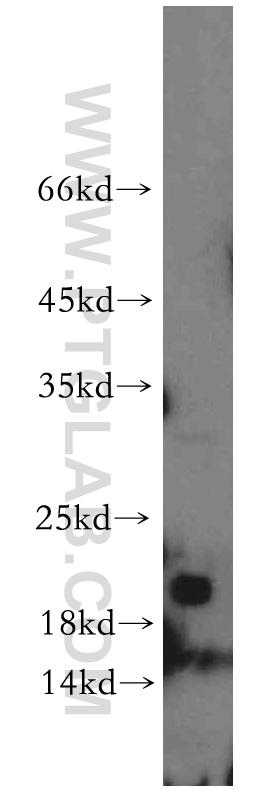验证数据展示
经过测试的应用
| Positive WB detected in | mouse colon tissue |
推荐稀释比
| 应用 | 推荐稀释比 |
|---|---|
| Western Blot (WB) | WB : 1:200-1:1000 |
| It is recommended that this reagent should be titrated in each testing system to obtain optimal results. | |
| Sample-dependent, Check data in validation data gallery. | |
产品信息
12069-1-AP targets NBL1 in WB, ELISA applications and shows reactivity with human, mouse, rat samples.
| 经测试应用 | WB, ELISA Application Description |
| 经测试反应性 | human, mouse, rat |
| 免疫原 | NBL1 fusion protein Ag2706 种属同源性预测 |
| 宿主/亚型 | Rabbit / IgG |
| 抗体类别 | Polyclonal |
| 产品类型 | Antibody |
| 全称 | neuroblastoma, suppression of tumorigenicity 1 |
| 别名 | D1S1733E, DAN, DAN domain family member 1, DAND1, NB, NBL1, NO3, Protein N03, Zinc finger protein DAN |
| 计算分子量 | 180 aa, 19 kDa |
| 观测分子量 | 19 kDa |
| GenBank蛋白编号 | BC012037 |
| 基因名称 | NBL1 |
| Gene ID (NCBI) | 4681 |
| RRID | AB_10638604 |
| 偶联类型 | Unconjugated |
| 形式 | Liquid |
| 纯化方式 | Antigen affinity purification |
| UNIPROT ID | P41271 |
| 储存缓冲液 | PBS with 0.02% sodium azide and 50% glycerol , pH 7.3 |
| 储存条件 | Store at -20°C. Stable for one year after shipment. Aliquoting is unnecessary for -20oC storage. |
背景介绍
NBL1 (neuroblastoma suppression of tumorigenicity 1), also named as DAN, is the founding member of the DAN subfamily. It was originally identified as a putative tumor suppressor gene in a transformed fibroblast rat model (PMID: 9516839), whereby it was significantly down-regulated in v-src-transformed rat fibroblasts. The MW of this protein is 19 kDa, and this antibody specially recognises the 19 kDa protein.
实验方案
| Product Specific Protocols | |
|---|---|
| WB protocol for NBL1 antibody 12069-1-AP | Download protocol |
| Standard Protocols | |
|---|---|
| Click here to view our Standard Protocols |
